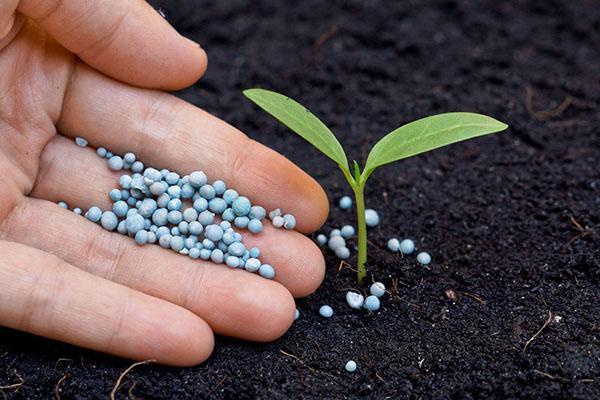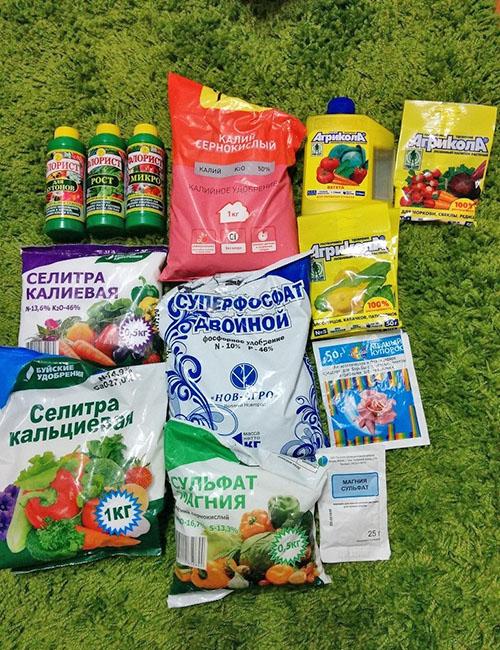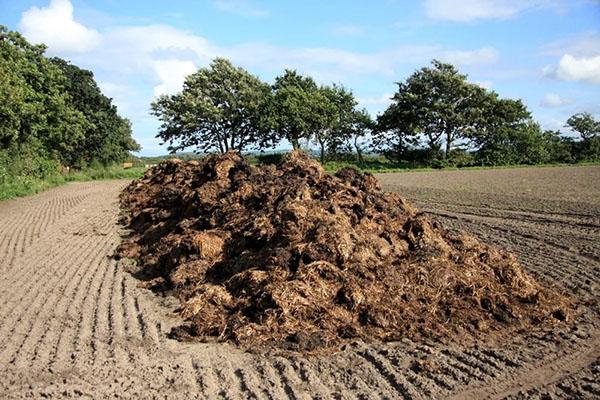Soils and fertilizers - what and how to apply
 The soil on the site can be different: sandy or clayey, acidic or calcareous. Plants are able to grow well on any of them, but only if the soil and fertilizers match each other.
The soil on the site can be different: sandy or clayey, acidic or calcareous. Plants are able to grow well on any of them, but only if the soil and fertilizers match each other.
Fertilizers

All fertilizers used in agriculture can be divided into 2 main groups: organic and mineral. Both those and others are distinguished by:
- state of aggregation - solid or liquid;
- mode of action - direct or indirect;
- purpose - main, pre-sowing, for feeding;
- method of introduction - superficial, for digging.
Natural fertilizers for the soil
 The most natural fertilizers for any type of soil are organic, that is, created by nature itself.
The most natural fertilizers for any type of soil are organic, that is, created by nature itself.
In order for the plantings to sprout together, grow and develop, in addition to heat and light, they need:
- saturation with nutrients;
- the presence of air and moisture in the soil;
- the presence of carbon dioxide.
To fulfill all three conditions, the earth must contain a large number of beneficial microorganisms. It is their development that is stimulated by the introduction of organic matter. They will ensure the transformation of nutrients into a form accessible to plants. Accelerate overheating of dead roots and other plant residues. The result is carbon dioxide and air channels in the soil. Through the channels, air and moisture will be able to penetrate to a great depth - directly to the roots of planted plants. The soil will become a living earth - loose, nutritious and moisture-consuming.
Organic fertilizers include manure, compost, humus and all types of peat. Horse manure is considered the best manure - it is very nutritious and decomposes well. Then comes the cow and sheep. Poultry manure can be a good fertilizer too, but it must be used with care. Too high a concentration can do more harm than good. Used in liquid form, diluted with water in a ratio of not less than 1:10.
Compost is not completely rotted organic residues. Almost all kitchen waste, sawdust, paper trimmings and similar materials can be placed in the compost heap.
Peat-manure composts are very useful, as well as prefabricated composts from a large number of different components.
Humus is a product of complete decomposition of organic residues. To obtain it, you can use manure, leaves, dead tops and other plant components. This fertilizer contains many nutrients in a form available to plants. 
Natural fertilizers are also siderates... They are also called green. To obtain, the beds should be sown with one of the fast-growing and unpretentious plants. This can be mustard, canola, annual lupine, or rye. Sowing should be done in the spring, before the main planting, or in the fall - after harvesting. Wait until they rise, let them grow a little, and then plow or cut with a flat cutter.
Siderat is one of the best autumn fertilizers for any soil.
Mineral fertilizers
 Mineral fertilizers are simple and complex. Simple ones will saturate the soil with any one element. This can be phosphorus, potassium, calcium, or nitrogen. Or trace elements: iron, copper, boron and others. With complex fertilizers, several different substances will get into the soil at once.
Mineral fertilizers are simple and complex. Simple ones will saturate the soil with any one element. This can be phosphorus, potassium, calcium, or nitrogen. Or trace elements: iron, copper, boron and others. With complex fertilizers, several different substances will get into the soil at once.
Simple and double superphosphate are most often used as phosphorus fertilizers. They are brought in when digging in solid form.And in infusion they are used to feed plants.
The main disadvantage of phosphorus fertilizers is that they cannot be combined with lime.
Nitrogen fertilizers are ammonium nitrate, carbomide, sodium nitrate, ammonium nitrate. They are often used for root dressing in solution or dry.
Potash fertilizers - potassium sulfate, potassium chloride, potassium nitrate. They are suitable for digging and as feeding.
Disadvantages:
- potassium chloride, in addition to potassium, also contains chlorine, which has a bad effect on some plants;
- potassium nitrate is not only potash, but also nitrogen fertilizer, which must be taken into account when applying to the soil.
Fertilizers containing calcium are lime, chalk, dolomite flour. They are used to reduce soil acidity and improve conditions for the development of soil microflora.
Soil types
 Soils suitable for agriculture are distinguished by type:
Soils suitable for agriculture are distinguished by type:
- Clay - soils containing at least 40% pure clay. They are usually sticky, moist, viscous, heavy, and cold. But there are quite a lot of nutrients in them. Such soils slowly absorb water and pass it poorly into the lower layers. Plants planted on them rarely suffer from a lack of moisture. Main disadvantages: they are very difficult to process, they turn to stone and crack when dry, and become limp in wet weather.
- Sandy - friable, containing about 50 times more sand than clay. They absorb well, but poorly retain water. With water, nutrients are washed out of them. These soils warm up very quickly, but also cool down.
- Sandy loam - those where the ratio of sand and clay is 7: 3. They are crumbly, retain moisture well, and are favorable for plant growth.
- Loam - contains more than 70% clay. They are light, medium and heavy. Rich in nutrients and minerals. These are breathable and easily cultivated soils.
- Podzolic - soils formed in places where coniferous forests grow. They have high acidity and poor fertility.
- Peat - formed under the influence of constant strong waterlogging. They conduct heat poorly, warm up slowly. They have high acidity.
- Chernozems are the most fertile soils. They are distinguished by their dark color and high humus content.
Soils and fertilizers

To choose the right fertilizer for the soil, you need to consider:
- soil type;
- season;
- weather.
The same fertilizer can be great for the site in the spring, and be harmful in the fall.
Hard and poorly soluble mixtures are convenient to use in wet weather - the nutrients will not be washed out too quickly by rains. But they will be completely useless during a drought.
How to fertilize clay soil
 The main task of fertilizing loam is to make it suitable for planting cultivated plants. This means: increase breathability and reduce moisture. Therefore, before starting to fertilize clay soil with mineral fertilizers, it is necessary to introduce organic matter into it. Initial processing will require at least one and a half buckets per square meter.
The main task of fertilizing loam is to make it suitable for planting cultivated plants. This means: increase breathability and reduce moisture. Therefore, before starting to fertilize clay soil with mineral fertilizers, it is necessary to introduce organic matter into it. Initial processing will require at least one and a half buckets per square meter.
On clay soil, manure lasts up to 8 years. On lighter soils - only 4 years.
In the future, it is useful to use a mixture:
- manure - 10 kg;
- potassium nitrate - 100 g;
- sawdust 2 kg.
Sawdust can be soaked in solution urea - about 100 g per bucket of water.
A good autumn fertilizer for clay soil will be siderates from legumes. They are sown at the beginning of summer, and at the end they are dug up, without waiting for flowering. You can just cut the greens with a flat cutter and lightly mix it with the top layer of the earth.
Sand as a fertilizer is used to loosen too dense soil. It is also introduced in the fall, along with organic matter. Each square meter will require at least three buckets of sand.
Before applying mineral fertilizers, you should determine the acidity of the soil. To do this, simply look at the vegetation.Plantain, woodlice and horsetail grow better on acidic soil. Clover, chamomile and bindweed can be seen on neutral more often.
Fertilizers for acidic soil
 If it turns out that the soil on the site is acidic, you will have to add lime fertilizers to it. Usually slaked lime or chalk is used for this purpose. Both are better to bring in in the fall, for digging. Wood ash is also suitable for this purpose. But not together with manure. Otherwise, a significant part of nitrogen from organic matter will be lost.
If it turns out that the soil on the site is acidic, you will have to add lime fertilizers to it. Usually slaked lime or chalk is used for this purpose. Both are better to bring in in the fall, for digging. Wood ash is also suitable for this purpose. But not together with manure. Otherwise, a significant part of nitrogen from organic matter will be lost.
The best fertilizer for acidic soil in spring is dolomite flour. It goes well with both organic and mineral supplements. In addition to reducing acidity, it will additionally saturate the soil with magnesium.
Fertilizers for sandy soil
 The main task of fertilizing sandy soil is to increase its viscosity and moisture capacity. For this purpose, clay is used, peat, manure and composts.
The main task of fertilizing sandy soil is to increase its viscosity and moisture capacity. For this purpose, clay is used, peat, manure and composts.
The clay is used as a dry powder. If four buckets per square meter are brought in every spring, then in 3-4 years the earth will turn into sandy loam. To speed up this process, organic matter is added in the fall - peat and manure. For one square meter, you will need 2 buckets of organic fertilizer.
Mineral fertilizers are applied to sandy soil in spring or early summer. Otherwise, most of them will be carried into deep layers along with water. Ash and dolomite flour are used for deoxidation.
With proper care, you can cultivate any land. Even infertile podzols and waterlogged peatlands. You just need to choose the right fertilizer for the soil and spare no time in processing it.